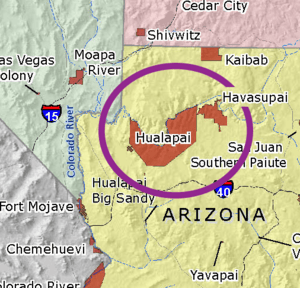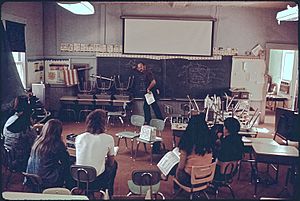Havasupai–Hualapai language facts for kids
Quick facts for kids Havasupai–Hualapai |
||
|---|---|---|
| Havasupai Upland Yuman |
||
| Region | Arizona, United States | |
| Ethnicity | 570 Havasupai, 1,870 Walapai (2007) | |
| Native speakers | Hualapai: about 1,000, all ages (2015 census)e18 Over 500 Havasupai, all ages (2007) |
|
| Language family |
Yuman–Cochimí
|
|
| Dialects |
Havasupai
Hualapai
|
|
| Writing system | Latin | |

The Hualapai and Havasupai reservations are circled on this map in purple, where most speakers of the language live.
|
||
| Template:Infobox language/ipa
|
||
Havasupai–Hualapai is a Native American language. It is spoken by the Hualapai and Havasupai people. These groups live in northwestern Arizona, in the United States.
This language belongs to the Pai branch of the Yuman–Cochimí language family. It is closely related to the Yavapai language. Another related language is Paipai, spoken in northern Baja California.
There are two main ways Havasupai–Hualapai is spoken, called dialects. The Havasupai dialect is used in the bottom of the Grand Canyon. The Hualapai dialect is spoken along the southern rim. In 2010, about 1,500 people spoke Havasupai-Hualapai. UNESCO says the Havasupai dialect is endangered. The Hualapai dialect is considered vulnerable. People are working to save both dialects. They use special education programs that teach in both languages.
Contents
How Havasupai and Hualapai are Similar
The Hualapai and Havasupai people are separate groups. However, language experts agree that their ways of speaking are very similar. They are considered dialects of the same language, not completely different languages. The differences between them are very small.
The Havasupai–Hualapai language is also similar to the Yavapai language. Sometimes, these languages are grouped together. A Yavapai speaker once said that Hualapais "speak the same language as we do." He noted only "some words or accents are a little different."
Sounds of the Language
Consonant Sounds
The Hualapai dialect has many different consonant sounds. Some of these sounds are not found in English. For example, some sounds are made with a puff of air, like a 'p' or 't' sound. This is called aspiration.
The language also has long and short vowel sounds. This means how long you hold a vowel sound can change a word's meaning. For example, 'pa:ʔ' means "person," but 'paʔ' means "arrow."
Vowel Sounds
Havasupai–Hualapai has several vowel sounds. Some vowels can be long or short. When vowels are not stressed, they can sometimes be shortened or even disappear. The language also has sounds called diphthongs. These are like two vowel sounds blended together, such as the 'ow' sound in "cow."
Word Stress
In Havasupai–Hualapai, some parts of words are stressed more than others. This stress helps decide how words are pronounced. It also affects where long vowels appear. There are different levels of stress: primary, secondary, and weak. Primary stresses happen at regular times when someone is speaking.
How Words are Built
Havasupai–Hualapai adds small parts to words to change their meaning. These small parts are called affixes. They can be added to nouns, verbs, and other words. Some affixes can even change a noun into a verb or a verb into a noun. These affixes are usually short.
Verbs
Verbs in Havasupai–Hualapai show who is doing the action. They use prefixes like 'a-' for "I," 'ma-' for "you," and 'ø-' for "he/she/it." Verbs also have suffixes. These suffixes give more information. They can tell you when something happened (tense). They can also tell you if an action is ongoing or finished (aspect).
The language can show if there is one, a few, or many people doing an action. There are six types of aspect markers. These markers show how an action happens. For example, if it happens over and over, or if it is finished.
Nouns
Nouns also have prefixes and suffixes. These tell you more about the noun.
- Noun prefixes:
- Subordinate: /-ɲi/ means "related to."
- Intensive: /vi-/ means "very" or "just."
- Noun suffixes:
- Number: /-t͡ʃ/ for a few, /-uv/ for many. No suffix is used for a single item.
- Demonstrative: /-ɲ/ means "that," and /-v/ means "this."
- Definiteness: Suffixes like /-a/, /-i/, /-u/, /-o/ show if something is "the" one you are talking about.
- Case: Suffixes like /-t͡ʃ/ or /-ø/ show the noun's role in the sentence. For example, who is doing the action or who the action is done to.
- Appellative: /-é/ is used when calling out to someone.
Particles
Particles are words like interjections (like "oh!"), adverbs (words that describe verbs), and pronouns (like "my"). There are not many particles in this language. They can also have prefixes for subordination and intensity, just like nouns. They can also have the suffix /-é/ to show a place.
Sentence Structure
Word Order
The basic word order in Havasupai–Hualapai sentences is Subject-Object-Verb (S-O-V). This means the person or thing doing the action comes first. Then comes the person or thing the action is done to. Finally, the action word (verb) comes last. For example, "The boy the ball kicked."
Case Marking
Havasupai–Hualapai uses a system called nominative/accusative case marking. This means that nouns change slightly depending on whether they are the subject (doing the action) or the object (receiving the action) in a sentence.
How the Language is Written
Havasupai and Hualapai have their own ways of writing. These writing systems were created to help keep the tribes' social and cultural identities separate. The Hualapai writing system was developed in the 1970s. This was done to help save the language and teach it. Both writing systems use letters from the Latin Script, which is the alphabet English uses.
| a | ae | b | ch | d | đ | e | f | g | h | i | k | l | m | n |
| ny | ng | o | p | q | s | t | th | ŧ | u | v | w | y | ’ |
Havasupai Dialect
The Havasupai dialect is spoken by about 639 people. They live on the Havasupai Indian Reservation. This reservation is located at the bottom of the Grand Canyon.
A 2015 New York Times article said that Havasupai was the only Native American language in the United States spoken by 100% of its tribal members. As of 2005, Havasupai was still the main language for people living in Supai Village. This is where the tribal government is located.
Religious texts were printed in Havasupai in 1934. These included the Lord's Prayer, John 3:16 from the Bible, and hymns. As of 2004, a project was underway to translate the Old and New Testaments into Havasupai. This project was moving slowly.


